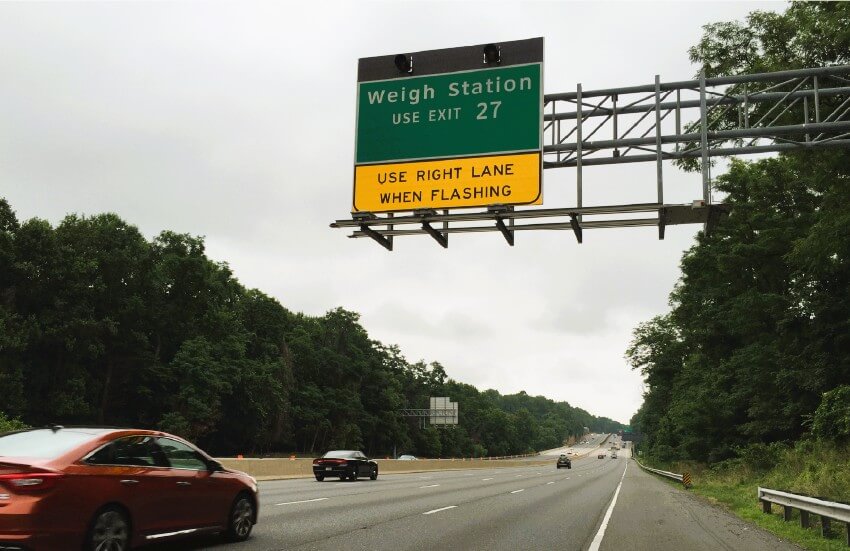How cellular connectivity helps DOTs
by Webbing Team | October 1, 2025
In addition to the IoT systems that make roads safer and help monitor and manage traffic flow, there’s a layer of infrastructure that quietly keeps highways running: the systems that apply rules on the ground and protect assets and revenue.
Highways and city streets aren’t the same – neither in terms of operations nor in terms of connectivity. In cities, the focus is mainly on pedestrian and cyclist protection, transit signal priority, emergency preemption and parking management. On highways, the picture is different: without any traffic lights, Department of Transportations (DOTs) need to keep high-speed flows stable and safe for long distances, and what is most important, handle incidents quickly. In connectivity, cities can optimize dozens of closely spaced communication nodes with frequent signal updates and dense communication networks. Highways manage fewer sites that are far apart from each other, oftentimes with no access to fixed infrastructure, but with emphasis on fast response. Success measures differ, too: cities track safety for vulnerable users or intersection delay, while highways track travel-time reliability, accident reduction, throughput, and compliance.
Oftentimes, highways use the same devices as in the city streets for the same purpose, such as cameras for speed detection or traffic flow monitoring. But some of the systems and roadside units are very specific for highways and have distinct connectivity requirements:

Tolls
Toll roads make up a tiny share of total public road mileage, but they carry heavy volumes of traffic, often far above typical roads. Last year, FHWA reported that as of January 1, 2023, the U.S. had 6,759 miles of tolled roads, bridges, and tunnels in operation. At the same time, a single tolled system, the New York State Thruway, accounted for 17.4 billion vehicle miles traveled.
In both staffed and fully automatic tolling systems, cellular connectivity is needed to reliably move tolling data and controls between field sites and the back office. Field sites generate evidence that a vehicle owes a charge, for example, when a plate or DSRC tag is read, or an axle class is detected. Event records from local subsystems such as ANPR cameras, DSRC readers, classification sensors and beacons are collected and bundled for upload over LTE/5G. Small, time-sensitive messages like alarms post quickly, but the upload of bigger files like image or video evidence is often scheduled and depends on good bandwidth and coverage.
Cellular networks are often the easiest way to connect toll systems, because they’re already everywhere, so the roadside gear can report in reliably without waiting for fiber to be built. This approach is widely used on highways with open-road tolling, in rural stretches where running cables is difficult, at seasonal toll points, and in distance-based charging systems that rely on vehicle location. Even where fiber exists, agencies usually keep a cellular link ready as backup so tolling keeps working during outages, protecting revenue and avoiding disruption.
Cellular-enabled tolling systems have been in use for almost a decade now, for example, in Uruguay and in Germany. However, the emergence of 5G revolutionized the capabilities of mobile communication, and industry experts expect it to have a substantial impact on the tolling market in coming years.

Weigh Stations
Weight screening on highways includes mainline screening and linking to enforcement sites, and both typically use cellular technology. In mainline screening, high-speed weigh-in-motion (WIM) sensors that are embedded in the pavement estimate axle and gross weights as trucks pass at freeway speed, and the roadside cabinet sends each record via cellular to the agency’s back office or a virtual weigh station. Upstream of weigh stations, those WIM sites also use cellular to alert the station when a truck is likely overweight, so beacons direct it to pull in.
At the station, low-speed sensors and static scales perform the legal verification. Some weigh control stations may have wired connectivity, but cellular is still common either as the primary link, especially at rural sites or seasonal facilities, or as a hot standby for resiliency. Cellular networks also connect station beacons to the center, that’s how portable low-speed WIM systems get online quickly.

Work Zones
Work-zone operations use cellular connectivity to give operators a live picture of what’s happening in the zone, spot forming queues and warn drivers early. Because these zones are temporary or mobile, cellular networks are the primary way they connect to the traffic center. A typical setup here is a portable trailer with its own solar battery, GPS for location, and a controller that manages attached devices. Those devices can include a radar or LiDAR unit to measure speeds and detect slow-downs, an optional camera for snapshots or video clips, and a portable dynamic message signs or arrow board to display messages and lane closures. The trailer’s controller uses LTE or 5G networks to send detections and location to the center, and to receive message text, symbols, and timing so signs can be updated instantly when conditions change.
In day-to-day operation, the detection feed is used to trigger queue warnings upstream and adjust message wording as work moves. If the work shifts a few miles overnight, the same trailers are towed to the new location, powered on, acquire signal, and automatically connect so the center starts receiving data and can push new messages without a field technician reprovisioning anything.
These trailers are used on freeway resurfacing projects, bridge rehabs, shoulder or lane-addition jobs, and emergency repairs, basically anywhere a highway needs short-term detection and messaging. The value of cellular here is speed and flexibility: agencies can stand up and tear down a functioning work-zone system in hours and update messages depending on live conditions.

Connectivity Requirements
Cellular connectivity is essential for modern highway operation systems as it links their multiple elements. Each of these elements may have specific connectivity demands but there are some common requirements that are relevant for most of the systems.
Latency
Latency is one of the most critical parameters when it comes to road operations, and not only for the reasons of safety. DOTs also need to react to incidents quickly to keep traffic flow stable. However, while cellular technology can provide latency as low as 1ms, the actual latency depends on your connectivity provider’s core network architecture, since the data needs to travel all the way to the data center before following to its destination.
Coverage and Bandwidth
In highway operations, stable connectivity is crucial for all use cases. Since cellular connectivity is the only viable option for deployments in rural locations and areas with no fixed lines of communication, coverage is one of the major concerns. Though there are cellular networks almost everywhere, each of them inevitably has its weak spots. Poor network coverage, especially outside of urban areas can be a serious challenge for smart transportation projects. Case studies show that toll road authorities specifically seek multi-carrier cellular connectivity and failover at toll collection locations. The emergence of eSIM that is capable of storing multiple carrier profiles and a new remote provisioning standard SGP.32 is a major advancement, but it still is important that your connectivity solution can seamlessly switch between carriers automatically when the connection is lost.
If the highway system includes cameras that stream live video, they also require a significant amount of bandwidth. Here organizations that deploy these systems are dependent on a cellular connectivity provider to guarantee a robust and reliable connection. So at the contracting stage, it’s important to make sure there are no additional limitations such as throttling.
Compliance with Regulations
In any country there are legislative acts that can impact the usage of cellular-connected devices. Starting with strictly technical aspects, there are also regulations on data transfer, privacy and sovereignty, industry specific or local regulations that need to be complied with. To make it worse, legislation is always subject to change. That means that enterprises deploying IoT devices as part of traffic management systems may have problems down the line if their connectivity solution is not adaptive enough to comply with regulations.

Webbing’s Connectivity Solution for Highway Operations
Webbing provides reliable, low-latency internet connectivity for mobility management solutions that drive improvements in traffic flow, connected vehicles, parking management, and the efficiency of highway operations. Through our collaboration with multiple partners such as Network Optix, a pioneer in enterprise video infrastructure software, we’re empowering transportation agencies to overcome congestion and enhance safety.
Webbing’s connectivity solutions guarantee global coverage, and through our ecosystem of over 600 mobile operators worldwide, devices can roam seamlessly across multiple carriers’ networks in every region. It solves the problem of weak spots that any mobile network may have and ensures full coverage and continuous connectivity for all devices, even at remote locations.
Webbing is a full MVNO that has a fully redundant distributed core network infrastructure with data centers on every continent. It is well suited to support mission-critical, high-data consumption type of use cases and provides connectivity stability and low latency. It also allows for all types of localization, making it easy to comply with local regulation requirements even in heavily regulated markets.
Our eSIM solution ensures failover connectivity with the capability of using multiple mobile carrier profiles, easily changing carriers at any time, and an option to fall back from a failing profile to a different profile without any need to communicate with a remote server. Webbing also offers a portal to manage eSIMs throughout their lifecycle. It allows for defining business rules that govern the automatic profile swap process and provides visibility to profile usage and network events, to guarantee transparent connectivity. With Webbing’s solution organizations can manage connected devices in bulks, easily scale global IoT deployments, monitor and control data usage of each device.
Our solutions help organizations overcome their connectivity problems and reduce time to market for global deployments, providing the benefits of roaming with multiple carrier options and seamless transition between carriers with a single SIM.
Reach out today to learn more about Webbing’s connectivity solutions for highway operations.




